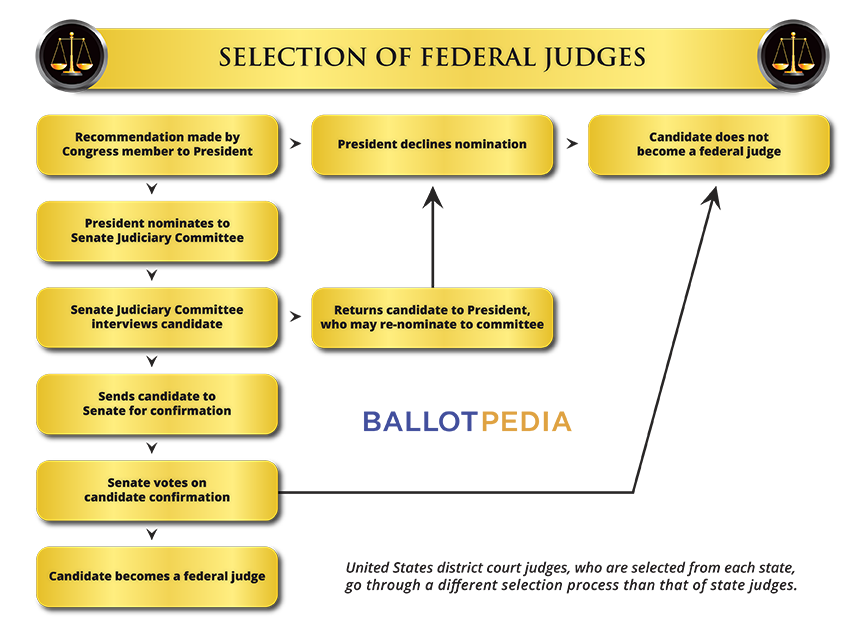Judicial selection in Wyoming
| Judicial selection in Wyoming | |
 | |
| Wyoming Supreme Court | |
| Method: | Assisted appointment |
| Term: | 8 years |
| Wyoming District Courts | |
| Method: | Assisted appointment |
| Term: | 6 years |
| Wyoming Circuit Courts | |
| Method: | Assisted appointment |
| Term: | 4 years |
Judicial selection refers to the process used to select judges for courts. At the state level, methods of judicial selection vary substantially in the United States, and in some cases between different court types within a state. There are six primary types of judicial selection: partisan and nonpartisan elections, the Michigan method, assisted appointment, gubernatorial appointment, and legislative elections. To read more about how these selection methods are used across the country, click here.
This article covers how state court judges are selected in Wyoming, including:
As of April 2025, the selection of state court judges in Wyoming occurs primarily through assisted appointment.[1] Newly appointed judges serve short initial terms of at least one year, after which they must run in yes-no retention elections if they wish to remain on the court.[2]
Click here to notify us of changes to judicial selection methods in this state.
Wyoming Supreme Court
- See also: Wyoming Supreme Court
The five justices of the Wyoming Supreme Court are selected through the assisted appointment method. When a vacancy occurs, the governor appoints a replacement from a list of three names provided by a nominating commission. There are seven members on the commission. Three members must be lawyers appointed by the state bar and three must be non-lawyers appointed by the governor. The chief justice of the supreme court serves as chairman and only votes in the event of a tie. The governor must appoint a person from the commission's list.[3][4]
Newly appointed judges serve for at least one year, after which they must stand for retention in the next general election. If retained, a judge will finish the remainder of his or her predecessor's unexpired term. Subsequent terms last eight years.[5][6]
Qualifications
To serve on the supreme court, a judge must be:
- a U.S. citizen;
- a state resident for at least three years;
- at least nine years legal experience;
- no younger than 30 years old; and
- no older than 70.*[5]
Chief justice
The chief justice of the supreme court is selected by peer vote, serving in that capacity for four years.[3]
Vacancies
When a vacancy occurs, the governor appoints a replacement from a list of three names provided by a nominating commission. After the appointed justice has served at least one year, they must stand for retention in the next general election. If retained, a judge will finish the remainder of his or her predecessor's unexpired term. Subsequent terms last eight years.[3]
The map below highlights how vacancies are filled in state supreme courts across the country.
Wyoming District Courts
- See also: Wyoming District Courts
Judges of the Wyoming District Courts are chosen by the governor, who appoints a replacement from a list of three names provided by a nominating commission. The governor must choose a nominee from the list provided by the commission.[7] Newly appointed judges serve for at least one year, after which they must stand for retention in the next general election. If retained, a judge will finish the remainder of his or her predecessor's unexpired term. Subsequent terms last six years .[2][7]
Limited jurisdiction courts
Wyoming has three types of limited jurisdiction courts: Wyoming Circuit Courts, Wyoming Municipal Courts, and Wyoming Chancery Court.
Wyoming Circuit Courts
Judges of the Wyoming Circuit Courts are chosen through the same assisted appointment method used to select appellate and district judges. When a vacancy occurs, the governor appoints a replacement from a list of three names provided by a nominating commission. The governor must choose a nominee from the list provided by the commission.[8]Newly appointed judges serve for at least one year, after which they must stand for retention in the next general election.[9] Subsequent terms last four years.[8] Circuit court judges must be members of the state bar and qualified electors of the state.[9]
Wyoming Municipal Courts
Judges of the Wyoming Municipal Courts are usually appointed by the mayor of the municipality and confirmed by the council. Term lengths vary for this office. A law degree is not required but many municipal judges are lawyers.[7]
Wyoming Chancery Court
On March 15, 2019, Governor Mark Gordon (R) signed legislation that created the chancery court.[10] Judges of the Wyoming Chancery Court are chosen through the same assisted appointment method used to select appellate judges. When a vacancy occurs, the governor appoints a replacement from a list of three names provided by a nominating commission. The governor must choose a nominee from the list provided by the commission. Newly appointed judges serve for at least one year, after which they must stand for retention in the next general election. Subsequent terms last six years.[11]
History
Below is a timeline noting changes to judicial selection methods in Wyoming.
- 2000: The county court was renamed the circuit court. Its geographic boundaries were the same as those of the district court.
- 1977: A merit selection plan was also established to apply to county court (later known as circuit court) judges.
- 1976: Established that confirmation by the judicial nominating commission was no longer required for judges seeking retention.
- 1972: The constitution was amended to create the Judicial Nominating Commission and the Judicial Supervisory Commission (now known as the Commission on Judicial Conduct and Ethics). The amendment also established a mandatory retirement age of 70.
- 1890: Established that supreme court justices were to be elected by popular vote to eight-year terms, and district court judges were to be elected to six-year terms.[12]
Courts in Wyoming
In Wyoming, there is one federal district court, a state supreme court, and trial courts with both general and limited jurisdiction. These courts serve different purposes, which are outlined in the sections below.
Click a link for information about that court type.
The image below depicts the flow of cases through Wyoming's state court system. Cases typically originate in the trial courts and can be appealed to courts higher up in the system.
Selection of federal judges
United States district court judges, who are selected from each state, go through a different selection process from that of state judges.
The district courts are served by Article III federal judges, who are appointed for life during good behavior. They are usually first recommended by senators (or members of the House, occasionally). The President of the United States nominates judges, who must then be confirmed by the United States Senate in accordance with Article III of the United States Constitution.[13]
In other states
Each state has a unique set of guidelines governing how they select judges at the state and local level. These methods of selection are:
Election
- Partisan election: Judges are elected by the people, and candidates are listed on the ballot alongside a label designating political party affiliation.
- Nonpartisan election: Judges are elected by the people, and candidates are listed on the ballot without a label designating party affiliation.
- Michigan method: State supreme court justices are selected through nonpartisan elections preceded by either partisan primaries or conventions.
- Retention election: A periodic process whereby voters are asked whether an incumbent judge should remain in office for another term. Judges are not selected for initial terms in office using this election method.
Assisted appointment
- Assisted appointment, also known as merit selection or the Missouri Plan: A nominating commission reviews the qualifications of judicial candidates and submits a list of names to the governor, who appoints a judge from the list.[14] At the state supreme court level, this method is further divided into the following three types:
- Bar-controlled commission: The state Bar Association is responsible for appointing a majority of the judicial nominating commission that sends the governor a list of nominees that they must choose from.
- Governor-controlled commission: The governor is responsible for appointing a majority of the judicial nominating commission that sends the governor a list of nominees they must choose from.
- Hybrid commission: The judicial nominating commission has no majority of members chosen by either the governor or the state bar association. These commissions determine membership in a variety of ways, but no institution or organization has a clear majority control.
Direct appointment
- Court appointment: Judges are selected by judges in the state judiciary.
- Gubernatorial appointment: Judges are appointed by the governor. In some cases, approval from the legislative body is required.
- Legislative election: Judges are selected by the state legislature.
- Municipal government selection: Judges are selected by the governing body of their municipality.
See also
External links
Footnotes
- ↑ Assisted appointment occurs when the governor selects a nominee from a list provided by a nominating commission.
- ↑ 2.0 2.1 American Judicature Society, "Methods of Judicial Selection: Wyoming," accessed August 11, 2021
- ↑ 3.0 3.1 3.2 Wyoming Judicial Branch, About the Supreme Court, accessed April 17, 2025
- ↑ Wyoming Judicial Branch, "Judicial Nominating Commission," accessed April 17, 2025
- ↑ 5.0 5.1 American Judicature Society, "Methods of Judicial Selection: Wyoming," accessed August 11, 2021
- ↑ American Judicature Society, "Methods of Judicial Selection: Wyoming," archived January 13, 2012
- ↑ 7.0 7.1 7.2 Wyoming State Bar, Judicial Branch FAQs, accessed April 17, 2025
- ↑ 8.0 8.1 Wyoming Judicial Branch, About the Circuit Courts, accessed April 17, 2025
- ↑ 9.0 9.1 American Judicature Society, "Methods of Judicial Selection: Wyoming; Limited Jurisdiction Courts," archived October 3, 2014
- ↑ Wyoming Judicial Branch, "About the Chancery Court," accessed April 19, 2023
- ↑ Wyoming Legislature, "SF0104 - Wyoming chancery court," accessed April 19, 2023
- ↑ American Judicature Society, "History of Reform Efforts: Wyoming," archived October 3, 2014
- ↑ U.S. Courts, "FAQ: Federal Judges," accessed March 26, 2015
- ↑ American Bar Association, "Judicial Selection: The Process of Choosing Judges," accessed August 10, 2021
Federal courts:
Tenth Circuit Court of Appeals • U.S. District Court: District of Wyoming • U.S. Bankruptcy Court: District of Wyoming
State courts:
Wyoming Supreme Court • Wyoming District Courts • Wyoming Circuit Courts • Wyoming Municipal Courts
State resources:
Courts in Wyoming • Wyoming judicial elections • Judicial selection in Wyoming







